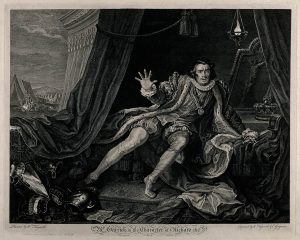By Ross MacFarlane
Research Engagement Officer
Wellcome Library
This Victorian engraving captures a key scene in one of Shakespeare’s most famous plays. Hamlet claims to have seen the ghost of his father.
Hamlet pointing to the ghost of his father and asking his mother the Queen if she can see it too. Engraving by T. Phillibrown after J.K. Meadows, c. 1834. Wellcome Library reference: 11539i.
His mother, the Queen, is disbelieving and takes Hamlet’s actions as further signs of his madness:
Hamlet: Do you see nothing there?
Queen Gertrude: Nothing at all; yet all that is I see.
Hamlet: Nor did you nothing hear?
Hamlet: Why, look you there! look, how it steals away!
My father, in his habit as he lived!
Look, where he goes, even now, out at the portal!
(Hamlet Act 4 Scene 3:131–136)
This opposition of belief and disbelief is at the heart of thinking about ghosts in Hamlet – are we meant to side with Hamlet in the possibility of him seeing a ghost or are we in agreement with his mother, that such a proclamation suggests an unsound mind?
Thinking about ghosts – not only in Hamlet but in Shakespeare’s other plays – allows us to consider contemporary attitudes to ghosts when these plays were written. In considering how these scenes were staged in the centuries since, we also might be able to read how beliefs in ghosts have changed over time.
A 19th century version of a Shakespearean ghost: Parnell as Macbeth and Dr Cronin as Banquo’s ghost in Macbeth. By: Tom Merry in St Stephen’s Review, 2 June 1889. Wellcome Library reference: 564962i.
A good deal of research into ghosts in Shakespeare’s plays has examined whether their mention reflects changing attitudes towards religion during Shakespeare’s lifetime. After the Reformation, the notion of purgatory – a state in which souls would reside temporarily, undergoing purification before entering heaven – was rejected. Without purgatory (to some early Protestant reformers), how could there be ghosts?
One contemporary book that tackled this change in how ghosts were considered was Of Ghosts and Spirites, Walking by Night,written by Ludwig Lavater in Latin in 1569 and translated into English in 1572.
Of Ghostes and Spirites, Walking by Night by Ludwig Lavater, London 1596 printing, title-page
In this compendium of accounts of sightings of ghosts, Lavater – a Swiss reformed pastor – argued for the impossibility of souls returning to earth before the Day of Judgement. His collection of sightings, ranging from the ancient to the contemporary, suggested to him that the living did witness visions of the dead, but these sightings were demonic in origin: ghosts were being sent to disturb, confuse and mislead Christians.
Change in how ghosts were perceived affected performances of Shakespeare’s plays. By the 18th century, belief in ghosts was deemed to be irrational by many, therefore their physical appearance on stage risked chortles of disbelief from an unbelieving audience, harming the serious tone of a performance.
As such, critics suggested that the fear of seeing a ghost was better expressed not by the appearance on stage of an actor playing the part of a ghost but instead through the expressions and physical movements of the actor playing the person who perceived the ghost. This idea can be illustrated by the great Shakespearian actor David Garrick (1717–1779).
David Garrick in the rôle of Richard III, awakening from his dream. Etching by W. Hogarth and C. Grignion after Hogarth, 1746. Wellcome Library reference: 39185i.
This etching, based on William Hogarth’s painting, captures Garrick’s Richard III on the eve of the Battle of Bosworth. The King has woken from a dream in which he has seen the ghosts of the opponents he had previously murdered. Garrick aims to capture the shock and fear of this visitation through his dramatic facial expression and outstretched hand.
Garrick would go to great lengths to induce shock and surprise. In his performance as Hamlet, the actor added an extra detail born of an age of mechanical automatons. He employed a hairdresser to construct for him a mechanical wig – so that when Hamlet first saw the ghost of his father, his hair seemed to stand on end.











